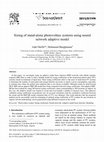Papers by Mohamed Benghanem

Procedia Engineering, 2012
This paper presents a data acquisition system with available components and study of the feasibil... more This paper presents a data acquisition system with available components and study of the feasibility of different existing methodologies linked to the field's data acquisition from remote photovoltaic (PV) water pumping systems. The data transmission serves to collect field's parameters such as water flow rate, global irradiation on an inclined and horizontal surface, voltage and current of photovoltaic field and ambient temperature. Various existing techniques are studied especially satellite, Radio, GSM (global system of mobile communication) and GPRS (general packet radio service). The system's hardware and software and an application to test its performance are described. The system will be used for reading, storing and analyzing information from several stations of PV water pumping located in remote areas in the arid region in the south of Tunisia. By this integrated system, we can constitute a complete data base of the different parameters related to PV water pumping systems in Tunisia. This data could be available on internet to interested parties.

IEEE Access
In this article, an artificial algorithm called hummingbirds optimization method, named AHA algor... more In this article, an artificial algorithm called hummingbirds optimization method, named AHA algorithm, is settled to extract accurately the parameters of PV modules under outdoor operational conditions. AHA is the main contribution in this work, regarding its efficiency and good performance in terms of standard deviation (StD), root mean square error (RMSE), sum of squared error (SSE), maximum number of iterations (MaxIt), particularly, for extracting parameter from modules operating in real conditions, and under different temperature and irradiance levels. The AHA is applied on a Polycrystalline-solar panel module type 320W-72P at real operating conditions and on a PV array of three polycrystalline PV modules connected in series. PV cells of the same modules are assumed operating under the same conditions where they share the same electric current and voltage values. In this last pattern, eight different scenarios are chosen. In the first five scenarios, the temperatures are (46.97, 44.23, 42.87, 40.59 and 30.60 • C), and the irradiance varies, such as (910, 800.57, 614.13, 415.1 and 200.87W/m2), respectively. In the other three testing scenarios, the solar irradiance is equal (803 W/ m2), and the temperature differs, such as T=47.93 • C, 53.38 • C and 36.62 • C. Lower values of root mean square errors (RMSE) are achieved (9.8602 × 10 −4 and 2.572533 × 10 −2 for RTC France PV cell and the 320W-72P module respectively) with 6000 iterations. Moreover, all the eight scenarios are lower than 7.245916 × 10 −2 for the last case study. Moreover, results show that we could recommend the AHA algorithm as an advanced and efficient method for dealing with real time parameter optimization of photovoltaic modules. In fact, a high closeness between the simulated and the experimental curves is achieved, which indicates the perfectness of this optimization method. Finally, the proposed AHA algorithm can be engaged as tools for the best designing of PV systems. INDEX TERMS Artificial hummingbird algorithm, photovoltaic cells, physical parameters, PV extraction.

Energies, 2021
To support farmers and improve the quality of crops production, designing of smart greenhouses is... more To support farmers and improve the quality of crops production, designing of smart greenhouses is becoming indispensable. In this paper, a novel prototype for remote monitoring of a greenhouse is designed. The prototype allows creating an adequate artificial environment inside the greenhouse (e.g., water irrigation, ventilation, light intensity, and CO2 concentration). Thanks to the Internet of things technique, the parameters controlled (air temperature, relative humidity, capacitive soil moisture, light intensity, and CO2 concentration) were measured and uploaded to a designed webpage using appropriate sensors with a low-cost Wi-Fi module (NodeMCU V3). An Android mobile application was also developed using an A6 GSM module for notifying farmers (e.g., sending a warning message in case of any anomaly) regarding the state of the plants. A low-cost camera was used to collect and send images of the plants via the webpage for possible diseases identification and classification. In this...
Advanced Materials Research, 2012
This study investigates the preparation of the three main layers of a CdS/CdTe thin film solar ce... more This study investigates the preparation of the three main layers of a CdS/CdTe thin film solar cell using a single vacuum system. A Close Space Sublimation System was constructed to deposit CdS, CdTe and CdCl2 solar cell layers. Two hot plates were used to heat the source and the substrate. Three fused silica melting dishes were used as containers for the sources. The properties of the deposited CdS and CdTe films were determined via Atomic force microscopy, scanning electron microscopy, X-ray diffraction and optical transmission spectroscopy. An J-V characterization of the fabricated CdS/CdTe solar cells was performed under solar radiation. The short-circuit current density, Jsc, the open-circuit voltage, Voc, fill factor, FF and conversion efficiency, η, were measured and yielded values of 27 mA/cm2, 0.619 V, 58% and 9.8%, respectively.

Journal of Non-Crystalline Solids, 2012
Differential scanning calorimetry (DSC) studies were performed under nonisothermal conditions at ... more Differential scanning calorimetry (DSC) studies were performed under nonisothermal conditions at various heating rates for glassy Se made by high-energy ball milling. Comparisons were made between the ballmilling technique and the melt-quenching and thin-film techniques. Well-defined endothermic and exothermic peaks were observed at the glass-transition temperature, T g , and the onset temperature of crystallisation, T c. The isoconversional method of Vyazovkin was used to determine the variation in the activation energy for crystallisation with temperature, E α (T). The value of E α (T) was dependent on the sample preparation method. The thermal stability of the Se glasses was evaluated by calculation of the temperature difference (T c − T g) and the S-parameter. In addition, the glass-forming ability was estimated by the criteria of reduced glasstransition temperature, T rg , and the Hruby number, H R. The structures of the Se samples that resulted from the DSC analysis were identified using an X-ray diffractometer. The glasses formed using the thin film technique were the most stable.

Energies, 2021
In this work, a smart solar still prototype for water desalination is designed. It consists of a ... more In this work, a smart solar still prototype for water desalination is designed. It consists of a basic solar still, a solar preheater and a remote monitoring system based on the Internet of Things (IoT) technique. The monitoring system is developed and integrated into the hybrid solar still in order to control its evolution online, as well the quality of the freshwater provided by checking measured parameters such as pH. Thanks to the IoT technique, parameters collected by the monitoring system (e.g., air temperatures, relative humidity, etc.) are uploaded to the cloud for online remote monitoring. The users are notified by an SMS about the status of the system (e.g., water level in the basin, water in the tank, etc.), using an GSM module. The whole system, including the preheater, water pump, valve, sensors and an electronic board, is powered by a photovoltaic module of 75 Wp. The results showed that by adding a solar preheater system, the evaporation process is accelerated and, co...

Coatings
ITO/PEDOT:PSS/P3HT:PC60BM/Mg-Al organic solar cells (OSCs) were fabricated depending on optimizat... more ITO/PEDOT:PSS/P3HT:PC60BM/Mg-Al organic solar cells (OSCs) were fabricated depending on optimization of Poly(3-hexylthiophene-2,5-diyl) (P3HT) and phenyl-C61-Butyric-Acid-Methyl Ester (PC60BM). The optimization of the active layer, P3HT:PC60BM, was carried out under different spin frequencies coating from 900 to 3000 rpm. The post-production annealing temperature of all prepared OSC was studied from 130 to 190 °C. The holes transport layer, poly(3,4-ethylene dioxythiophene) polystyrene sulfonate (PEDOT:PSS), was prepared under constant conditions of 3000 rpm for 35 s, and annealing temperature 178 °C for 15 min. From our study, the optimum conditions for P3HT:PC60BM were spin coating of 3000 rpm, and annealing temperature of 160 °C for 5 min. The optimum J-V parameters values for the prepared OSC were JSC = 12.01 mA/cm2, VOC = 660 mV, FF = 59%, PCE = 4.65%, and EQE = 61%. A complete OSC with acceptable efficiency was designed using simple and low-cost techniques that may be utilized...

IEEE Access
Forecasted global horizontal irradiation (GHI) can help for designing, sizing and performances an... more Forecasted global horizontal irradiation (GHI) can help for designing, sizing and performances analysis of photovoltaic (PV) systems including water PV pumping systems used for irrigation applications. In this paper, various deep neural networks (DNN) models for one day-ahead prediction of GHI at Hail city (Saudi Arabia) are developed and investigated. The considered DNN models include long-shortterm memory (LSTM), bidirectional-LSTM (BiLSTM), gated recurrent unit (GRU), bidirectional-GRU (Bi-GRU), one-dimensional convolutional neural network (CNN 1D) and other hybrid configurations such as CNN-LSTM and CNN-BiLSTM. A dataset of daily GHI recordings collected during January 1, 2000 to June 30, 2020 from National Aeronautics and Space Administration (NASA) at an arid location (Hail, Saudi Arabia) is used to develop and compare the above DNN-based models. The parameters affecting the accuracy of the models have been also deeply analyzed. Only historical values of daily GHI have been used to build the DNN-based models whereas additional weather parameters such as air temperature, wind speed, wind direction, atmospheric pressure and relative humidity are not considered in this work. Keras library and Python language have been used to develop and compare the GHI forecasting models. The evaluation metrics such as correlation coefficient (r), Mean Absolute Percent Error (MAPE), Mean Absolute Error (MAE), cumulative distribution function (CDF) and standard deviation (σ) are opted to evaluate the performance of the prediction models. The obtained results showed that the DNN models have provided globally good performances with a maximum reached value of r = 96%, for daily GHI forecasting.
International Journal of Power Electronics and Drive Systems (IJPEDS)
The present research shows the effect of dust accumulation on the surface of photovoltaic (PV) mo... more The present research shows the effect of dust accumulation on the surface of photovoltaic (PV) modules, which cause losses in their output power. We got 28% of losses in output power at Madinah city during 60 days of dust accumulation. Two ways were used to study the effect of dust on the PV modules of type monocrystalline silicon: the quantitative and the qualitative approaches respectively. A model based on dust density is used to determine the losses of output PV power. We propose to add an important parameter noted dust accumulation coefficient (%/mg.cm-2), in data sheet of PV modules manufacturer. In addition, an intelligent cleaning system is proposed, using the notion of dust density, to start cleaning when an admissible value of power losses is reached. This process allows minimizing the effect of dust.
Journal of Physics D: Applied Physics, 2016

Desalination, Apr 1, 2007
In this paper, we investigate using an adaptive radial basis function (RBF) network with infinite... more In this paper, we investigate using an adaptive radial basis function (RBF) network with infinite impulse response (IIR) filter in order to find a suitable model for sizing coefficients of the stand-alone photovoltaic (PV) systems, based on minimum of input data. These sizing coefficients allow to the users of stand-alone PV systems to determine the number of solar panel and storage batteries necessary to satisfy a given consumption, especially in isolated sites where the global solar radiation data is not always available. Obtained results by feed-forward MLP, RBF and an adaptive RBF-IIR model have been compared with real sizing coefficients. The adaptive RBF-IIR has been trained by using 200 known sizing coefficients values corresponding to 200 locations in Algeria. In this way, the adaptive model was trained to accept and even handle a number of unusual cases. The unknown validation sizing coefficients set produced very set accurate estimation with the correlation coefficient between the actual and the RBF-IIR model estimated data of 97% was obtained. This result indicates that the proposed method can be successfully used for estimating of optimal sizing coefficients of PV systems for any locations in Algeria, but the methodology can be generalized using different locations in the world.

Energy, Jul 26, 2010
In this paper, Radial Basis Function network (RBF) is used for modelling and predicting the daily... more In this paper, Radial Basis Function network (RBF) is used for modelling and predicting the daily global solar radiation data using other meteorological data such as air temperature, sunshine duration, and relative humidity. These data were recorded in the period 1998e2002 at Al-Madinah (Saudi Arabia) by the National Renewable Energy Laboratory. Four RBF-models have been developed for predicting the daily global solar radiation. It was found that the RBF-model which uses the sunshine duration and air temperature as input parameters, gives accurate results as the correlation coefficient in this case is 98.80%. A comparative study between developed RBF, Multilayer perceptron and conventional regression models are presented and discussed in this paper, In addition, an application for estimating the sizing of a stand-alone PV system at Al-Maidinah is presented in order to show the effectiveness of the developed RBF-model.

Bulletin of the American Physical Society, Oct 1, 2013
Arabia-Atmospheric pressure air cold plasma jet is introduced in this work. It is AC (60Hz to 20k... more Arabia-Atmospheric pressure air cold plasma jet is introduced in this work. It is AC (60Hz to 20kHz) cold plasma jet in air. The system is consisted of a cylindrical alumina insulator tube with outer diameter of 1.59mm and 26mm length and 0.80mm inner diameter. AC sinusoidal high voltage was applied to the powered electrode which is a hollow needle inserted in the Alumina tube. The inner electrode is a hollow needle with 0.80mm and 0.46mm outer and inner diameters respectively. The outer electrode is grounded which is a copper ring surrounded the alumina tube locates at the nozzle end. Air is blowing through the inner electrode to form a plasma jet. The jet length increases with flow rate and applied voltage to reach 1.5cm. The gas temperature decreases with distance from the end of the nozzle and with increasing the flow rate. The spectroscopic measurement between 200nm and 900nm indicates that the jet contains reactive species such as OH, O in addition to the UV emission. The peak to peak current values increased from 6mA to 12mA. The current voltage waveform indicates that the generated jet is homogenous plasma. The jet gas temperature measurements indicate that the jet has a room temperature.
Journal of Solar Energy Engineering, 2015
Hourly water flow rate (HWFR) forecasting is very important to photovoltaic water pumping system ... more Hourly water flow rate (HWFR) forecasting is very important to photovoltaic water pumping system (PVWPS) planning, operation, and control. In this paper, a nonlinear autoregressive with exogenous input-recurrent neural network (NARX-RNN) is investigated for the prediction of water flow rate (WFR) using experimental data collected from a PVWPS installed at Madinah site (Saudi Arabia). Results showed that the developed NARX-based model is able to reach acceptable accuracy for 1–12 hrs (next-day) ahead predictions. The developed methodology provides valuable information to PVWPS operators for controlling the production, storage, and delivery of water.
Mediterranean Journal of Measurement and Control
In this paper, an explicit model for accurate simulation of the I-V characteristic of photovoltai... more In this paper, an explicit model for accurate simulation of the I-V characteristic of photovoltaic (PV) cells and modules under various climatic conditions is described. The proposed model is found to be reliable and accurate in the situations where the model is a good approximation of cell or module performance. The developed model has been compared with the traditional I-V characteristic and with some experimental results. The obtained results showed the effectiveness of our model. Moreover, an experimental method is proposed to determine the series resistance and shunt resistance of the PV cells and modules.

2015 IEEE International Conference on Plasma Sciences (ICOPS), 2015
ABSTRACT Large volume atmospheric pressure air plasmas [1,2] were generated by applying ~ 100 ns ... more ABSTRACT Large volume atmospheric pressure air plasmas [1,2] were generated by applying ~ 100 ns high voltage pulse between two parallel electrodes separated by 48 mm gap in air. The generated plasma frequencies can be varied from single pulse to 2000 Hz. A uniformly distributed stainless steel pens were welded to the high voltage electrode while the grounded electrode is a metallic flat disc. The pens have 32 mm length and 0.48 mm radius and separated by 8.7 mm to form a brush-shape. The pin tips are cut to form sharp ends to enhance the applied electric field and reduced the ignition voltage. The atmospheric pressure large volume glow discharges plasma ignite first at the outer pens forming luminousness circle then the internal pens ignited with the increase in the applied voltage. The glowed plasma expanded to cover the gap by increasing the applied voltage. Each pens form glow discharge with the ground electrode. The plasma intensity and homogeneity enhanced with increasing the applied voltage or the plasma frequency. The emission spectra investigations declared the main presence of nitrogen bands, second positive band and first negative band in the investigated range between 200 nm and 800 nm. The generated plasma was successfully proved as an efficacious tool for sterilizing a wide range of fruits from the naturally occurring bacterial and fungal contamination. 1. Y. Song, D. Liu, W. Wang, L. Ji, Q. Zhang, W. Ni, and J. Niu, Plasma Process. Polym., vol. 10, 88 (2013). 2. A.H. Mohamed, A.A. Al-Mashraqi, S.M. Shariff, M. Benghanem, A.H. Basher, and S.A. Ouf, “Generation of Large Volume Atmospheric Pressure Air Plasma,” IEEE Trans. Plasma Sci., vol. 42, 2488 (2014).

Renewable and Sustainable Energy Reviews, 2015
ABSTRACT Prediction of water flow rate in a photovoltaic water pumping system (PVWPS) is of high ... more ABSTRACT Prediction of water flow rate in a photovoltaic water pumping system (PVWPS) is of high importance for investors who wish to achieve an efficient management of water demand in remote and desert areas. In this paper, different prediction methods based on Artificial Neural Networks (ANNs) have been investigated and compared. Data used to predict and estimate the hourly water flow rate have been acquired from an experimental PVWPS installed at Madinah site (Saudi Arabia). Results show that developed models can predict accurately the hourly flow rate based on measured hourly air temperature and solar irradiation, as input parameters. They can be used first to control the PVWPS by making a comparison between measured and predicted hourly flow rate, second to investigate the economic feasibility of the system to supply water in desert areas or isolated sites that have no access to an electric grid depending on water demand and finally fault detection based on the unexpectedly changing of delivered water amount. Operators can benefit from the proposed models. In fact, once their own PVWPS model is designed, they can predict its flow rate given the weather forecasts for the following day.
Proceedings of 2003 IEEE Conference on Control Applications 2003 CCA 2003 CCA-03, 2003
... 121 David B. Fogel, Evolutionary computation: Toward a new philosophy of machine intelligenc... more ... 121 David B. Fogel, Evolutionary computation: Toward a new philosophy of machine intelligence, IEEE, Institute ... [I41 NBKarayiannis, ANVenetsanopoules, Artificial neural network ... Bucciarelli, Estimating loss of load probabilities of stand alone photovoltaic solar energy system ...
IEEE Instrumentation and Measurement Technology Conference Sensing, Processing, Networking. IMTC Proceedings, 1997
In the present paper, the influence of the supply from PWM inverter in the heating distribution i... more In the present paper, the influence of the supply from PWM inverter in the heating distribution in induction motor is presented. The squirrel cage induction motor rated at 2.2 kW; 380 V; 50 Hz; 1420 rpm, has been thermally tested while being supplied alternatively from PWM inverter and sinusoidal voltage source. Many thermistors were placed in the rotor and stator










Uploads
Papers by Mohamed Benghanem